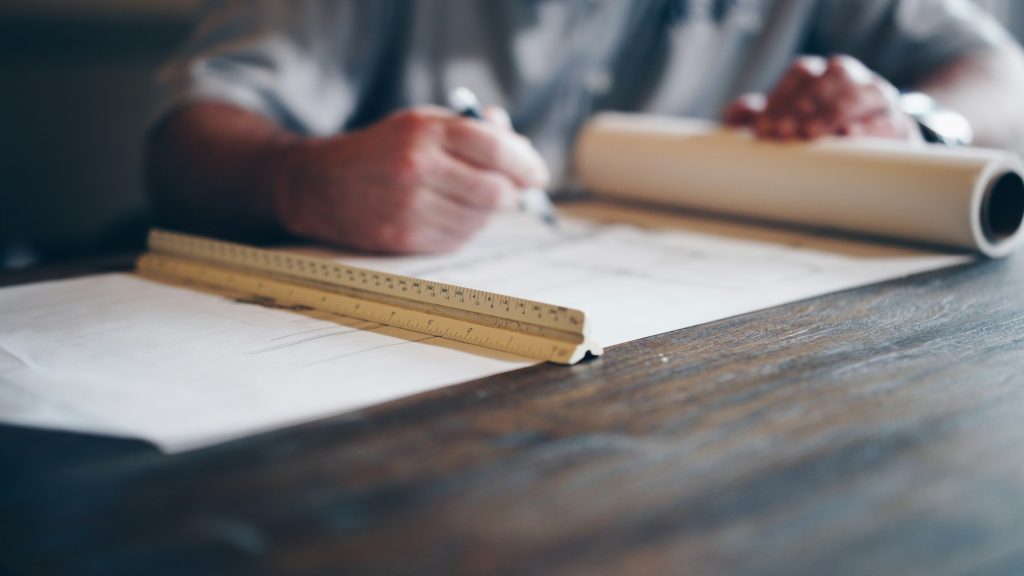You’ve finally saved enough money to start building your dream home. You may have looked at various house types and floor plans online, looked at fixtures and finishes, and built the home in your head.
Now it’s time to start looking for the perfect person to work with to make those dreams come true. A licensed architect can take your dream from the picture in your head to sketches to official drawings your contractor will follow to build.
Table of Contents
Interview Multiple Architects
Just as your employer interviewed multiple candidates for your position, you should interview multiple architects. You want to find someone you can work and communicate with throughout the process. Talk about your ideas, preferences, and budget from the start to make sure everyone is in sync.

As with any other job, ask for references and their portfolio. They may have a physical portfolio for you to look through, or have a digital portfolio on their website. Contact the references and take their feedback into consideration. These references are a reflection of the architect’s real-life attitude, professionalism, responsiveness, and other qualities you are looking for.
Establish Clear Communication
Once you’ve chosen an architect, establish a clear method of communication. Exchange phone numbers, email addresses, and current address with each other to ensure all lines of communication are open. If one form of communication works better than another, make that clear.
Have regular discussions and provide feedback throughout the design process to ensure the final design is what you had in mind and meets your needs and expectations.
Be Clear About Timeline
If you’re experiencing a life change at the same time you plan to undergo your custom home build, let your architect know. If you’re welcoming a new little one to the family in nine months and hope to be moved in before that, that’s a kep piece of information to let your architect know. If you’re moving an elderly parent in, that will be a key consideration for the architect as well. These constraints on your calendar can help the architect build an appropriate timeline for the project. Life changes like these could even influence your material choices: you may have to forgo the hand-painted Spanish tile imported directly from Barcelona in favor of something available locally so you can have it installed in a timely manner.
Be Clear About Budget
We know money isn’t always the most comfortable of topics, but just like disclosing your timeline needs, you need to be clear about your budget. We also know you don’t want to burn money. Even if the sky is the limit, have a number in mind. You may be able to afford whatever you want, but keep in mind lead times, possible shipping delays, and/or availability. You may have the money for the hand-painted Spanish tile, but there may be backordered, the shipping time may be too long, or there may not be enough to fill your order all at once. The final situation brings up other issues, like whether all the tiles will be the same shade, or painted exactly the same to match the ones you already have.

Having a budget in mind also reins you in a bit, and narrows your choices. Walk into any home improvement store and look at the number of lighting fixtures, bathroom fixtures, cabinet or drawer pulls, etc. There’s not just one, but dozens to choose from. Budgeting a firm number, like $50,000, and knowing your square footage and needs will make it a bit easier to make selections.
More About Money
You’ll sign a contract with your architect, which will likely include a fee structure. The fee structure may also be presented separately. No matter how it’s presented, make sure it outlines all the fees and payments and the payment schedule. You should also know what the fees cover – permit costs, the architect’s time/pay, etc.
Ask Questions
We don’t mean call your architect at 11 p.m. to ask your questions when they strike, but asking questions is key to communicating your needs and wants. Your custom home is a major investment of your time and money, and you’ll want to know what’s going on every step of the way. Your questions can also help your architect gauge what’s most important to you, even if you don’t come right out and say it.
There are no stupid questions and there are no annoying questions, and every question – and is answer – makes the design process easier and helps the architect design your dream. Asking questions from the start is a great way to save time in adjustments and changes later.
Have an Open Mind
Both you and your architect should have an open mind when it comes to the design and construction of your custom home. At the initial consultation, communicate your needs, wants, and ‘would like to haves’ to give the architect an idea of what you’re looking for.
The architect may do a quick drawing or sketch based on your description to help give your words direction. They may even offer suggestions and changes that you like even better.
The architect you choose should also have an open mind and be willing to work with the design you have in mind, while being amenable to changes and suggestions. If not, they may not be the architect for you.
Be Open & Honest
Years ago, I did not have the same love for cooking and baking as I do today – I’m not a chef by any means, but my skills have expanded from cooking frozen chicken, pasta, or browning meat for sloppy Joes to a wide range of dishes that means we may not have the same meal for a whole month. If I designed a custom home back then, I wouldn’t focus on the kitchen much. Today, however, I have a dream kitchen that includes a massive kitchen island, stainless steel appliances, and plenty of cabinets and drawers for all of my gadgets and small appliances.
On the other side of that coin, my home office doesn’t need to be anything big or fancy. Just a room that fits my desk, computer, and bookshelves and has a door that closes (and locks).
When it’s time to start designing, I’ll make sure to let my architect know about these preferences and needs. If I don’t speak up, honestly, their design might include a basic kitchen with a small island and minimal storage, and a home office with a view I’ll never look at. Of course I would correct them if that was what they showed me, but telling them my needs and wants up front makes it easier on both of us, saving time and money.
Expertise & Professionalism
Architects are trained and licensed professionals. They do more than generate drawings and blueprints. They navigate building codes, handle permitting issues, and help direct and keep the project as close to budget and timeline as possible. Things do come up that may slow or halt work – a large snowstorm during a Michigan winter can keep interior crews from reaching the jobsite and completing projects, or a sweltering Arizona desert summer will limit working hours due to the heat. Your architect can navigate these problems, take them into consideration when preparing a proposed timeline and budget, and more.
Once the design stage is over and construction has begun, your architect will be the go-to guy (or gal) who ensures the project is coming together as it should and fields questions from the contractor or subcontractors.
Final Thoughts
Architects are the most knowledgeable and experienced people to help make your dream home a reality. Now that you know a little more about how to find and work with an architect, you can take this knowledge and find the person or firm ideal for you and your needs.
Contact us today for a consultation!

